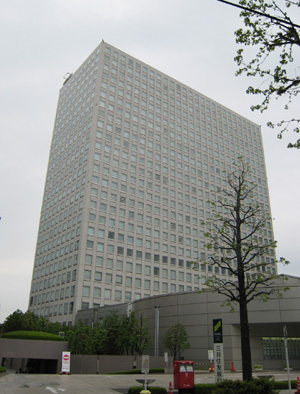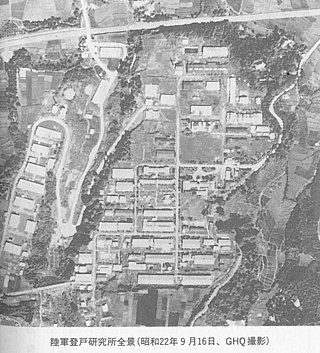
Kanagawa Prefecture is a prefecture of Japan located in the Kantō region of Honshu. Kanagawa Prefecture is the second-most populous prefecture of Japan at 9,221,129 and third-densest at 3,800 inhabitants per square kilometre (9,800/sq mi). Its geographic area of 2,415 km2 (932 sq mi) makes it fifth-smallest. Kanagawa Prefecture borders Tokyo to the north, Yamanashi Prefecture to the northwest and Shizuoka Prefecture to the west.

Sagami Bay lies south of Kanagawa Prefecture in Honshu, central Japan, contained within the scope of the Miura Peninsula, in Kanagawa, to the east, the Izu Peninsula, in Shizuoka Prefecture, to the west, and the Shōnan coastline to the north, while the island of Izu Ōshima marks the southern extent of the bay. It lies approximately 40 kilometres (25 mi) southwest of the capital, Tokyo. Cities on the bay include Odawara, Chigasaki, Fujisawa, Hiratsuka, Itō, and Kamakura.

The Sakai River is a Class B river in Tokyo and Kanagawa Prefecture which flows into the Bay of Sagami of the Pacific Ocean.

Fujisawa is a city in Kanagawa Prefecture, Japan. As of 1 June 2021, the city had an estimated population of 439,728 and a population density of 6300 persons per km2. The total area of the city is 69.57 square kilometres (26.86 sq mi).

Yamato is a city located in central Kanagawa Prefecture, Japan. As of 1 June 2021, the city had an estimated population of 242,065 and a population density of 8900 persons per km². The total area of the city is 27.09 km2 (10.46 sq mi).

Ebina is a city located in Kanagawa Prefecture, Japan.As of 1 June 2021, the city had an estimated population of 136,312 and a population density of 5100 persons per km2. The total area of the city is 26.69 square kilometres (10.31 sq mi).

IBM Research is the research and development division for IBM, an American multinational information technology company headquartered in Armonk, New York, with operations in over 170 countries. IBM Research is the largest industrial research organization in the world and has twelve labs on six continents.

Kōza District is a district located in central Kanagawa Prefecture, Japan. It currently consists of only one town, Samukawa. The entire cities of Chigasaki, Fujisawa, Yamato, Ayase, Ebina, Zama; and parts of the city of Sagamihara, were formerly part of Kōza District.

The Thomas J. Watson Research Center is the headquarters for IBM Research. The center comprises three sites, with its main laboratory in Yorktown Heights, New York, U.S., 38 miles (61 km) north of New York City, New York and with facilities in Cambridge, Massachusetts and Albany, New York.

Tokai University is a private non-sectarian higher education institution located in Tokyo, Japan. It was founded by Dr. Shigeyoshi Matsumae.

Atsugi is a city located in Kanagawa Prefecture, Japan. As of 1 June 2021, the city had an estimated population of 223,960 and a population density of 2400 persons per km2. The total area of the city is 93.83 square kilometres (36.23 sq mi). While the name "Atsugi" is often associated with the United States Navy base named Naval Air Facility Atsugi, the base is actually not in Atsugi, but straddles the border between the nearby cities of Ayase and Yamato.
Keio Media Centers is the English name used by Keio University in Japan to describe its library system.

Kanagawa Institute of Technology (KAIT) is a private university in Atsugi, Kanagawa Prefecture, Japan.

IBM Hakozaki Facility in Nihonbashi-Hakozaki-cho, Chuo-ku, Tokyo, Japan, is IBM's largest building in Japan, in terms of the number of people working there. It mainly houses IBM's marketing and market support departments, and – since October 2009 – headquarters, which moved from Roppongi, Tokyo. It was built for IBM in 1989.
The IBM Kanji System was announced in 1971 to support Japanese language processing on the IBM System/360 computers. It was later enhanced by the support of IBM System/34, IBM 5550 and DOS/V.

The history of IBM research in Israel dates from 1972 with the establishment of the IBM Haifa Research Lab. The research lab is located in a custom-built complex on the University of Haifa campus, with branches in Haifa and Tel Aviv. The staff at the IBM Haifa Research Lab works on projects connected to the topics of healthcare, cloud computing, formal and image and video analytics among others.

The Noborito Research Institute, officially the Army Ninth Technical Research Institute, was a military development laboratory run by the Imperial Japanese Army from 1939 to 1945. Based at a compound in the Noborito area of Tama-ku, Kawasaki, Kanagawa, the institute developed special weapons and equipment for covert operations. Noborito's projects included intelligence and spycraft items, counterfeit Chinese currency, chemical and biological weapons, and the Fu-Go balloon bomb.
IBM Toyosu Facility, located in Toyosu, Kōtō-ku, Tokyo, Japan, is one of the two largest facilities occupied by IBM in Tokyo, the other being IBM Hakozaki Facility. It mainly houses IBM's research and development, and delivery functions. The building is owned by Nippon Building Fund, affiliated to Mitsui Bank, and was built in 2004.
The Event Driven Executive (EDX) is a computer operating system originally developed by IBM for the control of research laboratory devices and experiments. It included an application programming language known as EDL and HCF, a Host Communication Facility.
IBM Fujisawa—located in Fujisawa, Kanagawa, Japan—was a manufacturing and development site of IBM Japan, Ltd., a subsidiary of IBM Corporation.















